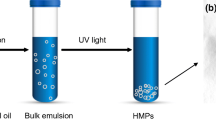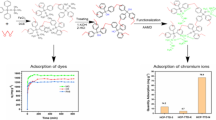Abstract
In this study, hydrophilic and hydrophobic site was fabricated onto the surface of polypropylene (PP) nonwoven for removal of bisphenol A (BPA). The adsorption behaviors as well as the adsorption driving forces were systematically analyzed. It is revealed that the amphiphilic PP nonwoven (PP-g-GMA-OA) had strong affinity towards BPA molecules and the predominant driving forces were hydrophobic interaction and hydrogen bonding. The hydrophobic site acted as adsorption site to provide hydrophobic interaction. The hydrophilic site accelerated the diffusion and adsorption process. In addition, the detailed connections between grated layer configuration and adsorption behaviors were observed and systematically elucidated. To ascertain the configurational transformation of grafted layer on PP surface, a microparticle grafting experiment was designed based on stimuli-responsive material measurement and the results indicated that the grafted layer had extended and contracted configuration with the variety of pH. Surface zeta potential measurement revealed that the configurarational transformation was mainly controlled by electrostatic interaction. On the basis of specially designed adsorption isotherm experiment, it is observed that extended configuration could offer more sites and slightly increased the adsorption capacity compared with contracted configuration.










Similar content being viewed by others
References
Hu Z, Si X, Zhang Z, Wen X (2014) Enhanced EDCs removal by membrane fouling during the UF process. Desalination 336:18–23
Janmanee P, Muttamara A (2012) Surface modification of tungsten carbide by electrical discharge coating (EDC) using a titanium powder suspension. Appl Surf Sci 258:7255–7265
Liu ZH, Kanjo Y, Mizutani S (2009) Removal mechanisms for endocrine disrupting compounds (EDCs) in wastewater treatment—physical means, biodegradation, and chemical advanced oxidation: a review. Sci Total Environ 407:731–748
Nakada N, Shinohara H, Murata A, Kiri K, Managaki S, Sato N, Takada H (2007) Removal of selected pharmaceuticals and personal care products (PPCPs) and endocrine-disrupting chemicals (EDCs) during sand filtration and ozonation at a municipal sewage treatment plant. Water Res 41:4373–4382
Yüksel S, Kabay N, Yüksel M (2013) Removal of bisphenol A (BPA) from water by various nanofiltration (NF) and reverse osmosis (RO) membranes. J Hazard Mater 263:307–310
Zhang P, Zhang G, Dong J, Fan M, Zeng G (2012) Bisphenol A oxidative removal by ferrate (Fe (VI)) under a weak acidic condition. Sep Purif Technol 84:46–51
Xu J, Wang L, Zhu Y (2012) Decontamination of bisphenol A from aqueous solution by graphene adsorption. Langmuir 28:8418–8425
Zhang Y, Cheng Y, Chen N, Zhou Y, Li B, Gu W, Xian Y (2014) Recyclable removal of bisphenol A from aqueous solution by reduced graphene oxide–magnetic nanoparticles: Adsorption and desorption. J Colloid Interface Sci 421:85–92
Bautista-Toledo I, Ferro-Garcia MA, Rivera-Utrilla J, Moreno-Castilla C, Vegas Fernández FJ (2005) Bisphenol A removal from water by activated carbon. Effects of carbon characteristics and solution chemistry. Environ Sci Technol 39:6246–6250
Wang D, Liu L, Jiang X, Yu J, Chen X, Chen X (2015) Adsorbent for p-phenylenediamine adsorption and removal based on graphene oxide functionalized with magnetic cyclodextrin. Appl Surf Sci 329:197–205
Kim YH, Lee B, Choo KH, Choi SJ (2011) Selective adsorption of bisphenol A by organic–inorganic hybrid mesoporous silicas. Microporous Mesoporous Mater 138:184–190
Cao F, Bai P, Li H, Ma Y, Deng X, Zhao C (2009) Preparation of polyethersulfone–organophilic montmorillonite hybrid particles for the removal of bisphenol A. J Hazard Mater 162:791–798
Pan B, Lin D, Mashayekhi H, Xing B (2008) Adsorption and hysteresis of bisphenol A and 17α-ethinyl estradiol on carbon nanomaterials. Environ Sci Technol 42:5480–5485
Kono H, Onishi K, Nakamura T (2013) Characterization and bisphenol A adsorption capacity of β-cyclodextrin–carboxymethylcellulose-based hydrogels. Carbohydr Polym 98:784–792
Chang KL, Hsieh JF, Ou BM, Chang MH, Hseih WY, Lin JH, Chen ST (2012) Adsorption studies on the removal of an endocrine-disrupting compound (Bisphenol A) using activated carbon from rice straw agricultural waste. Sep Sci Technol 47:1514–1521
Wei Q, Xiao X, Hou D, Ye H, Huang F (2008) Characterization of nonwoven material functionalized by sputter coating of copper. Surf Coat Technol 202:2535–2539
Teramoto K, Kimata S, Harada T, Chuman M, Sakohara S (2014) Separation of bisphenol-A by unimolecular micelles formed by pH-responsive polymer grafted onto polypropylene nonwoven fabrics. Chem Eng J 236:490–497
Chen J, Asano M, Yamaki T, Yoshida M (2006) Preparation and characterization of chemically stable polymer electrolyte membranes by radiation-induced graft copolymerization of four monomers into ETFE films. J Membr Sci 269:194–204
Nasef MM, Hegazy ESA (2004) Preparation and applications of ion exchange membranes by radiation-induced graft copolymerization of polar monomers onto non-polar films. Prog Polym Sci 29:499–561
Zhou X, Wei J, Zhang H, Liu K, Wang H (2014) Adsorption of phthalic acid esters (PAEs) by amphiphilic polypropylene nonwoven from aqueous solution: The study of hydrophilic and hydrophobic microdomain. J Hazard Mater 273:61–69
Tsai WT, Hsien KJ, Hsu HC (2009) Adsorption of organic compounds from aqueous solution onto the synthesized zeolite. J Hazard Mater 166:635–641
Dong Y, Wu D, Chen X, Lin Y (2010) Adsorption of bisphenol a from water by surfactant-modified zeolite. J Colloid Interface Sci 348:585–590
Zhao Z, Fu D, Ma Q (2014) Adsorption characteristics of bisphenol a from aqueous solution onto hdtmab-modified palygorskite. Sep Sci Technol 49:81–89
Joseph L, Zaib Q, Khan IA, Berge ND, Park YG, Saleh NB (2011) Removal of bisphenol a and 17α-ethinyl estradiol from landfill leachate using single-walled carbon nanotubes. Water Res 45:4056–4068
Ke S, Jie J, Keiluweit M, Kleber M, Wang Z, Pan Z (2012) Polar and aliphatic domains regulate sorption of phthalic acid esters (paes) to biochars. Bioresour Technol 118:120–127
Arunan E, Desiraju GR, Klein RA, Sadlej J, Scheiner S, Alkorta I, Kjaergaard HG (2011) Definition of the hydrogen bond (IUPAC Recommendations). Pure Appl Chem 83:1637–1641
Salim CJ, Liu H, Kennedy JF (2010) Comparative study of the adsorption on chitosan beads of phthalate esters and their degradation products. Carbohydr Polym 81:640–644
Acknowledgements
This research was supported by the Key Technologies R & D Program of Tianjin (15ZCZDSF00880) and National Natural Science Foundation of China (No. 51678409).
Author information
Authors and Affiliations
Corresponding author
Rights and permissions
About this article
Cite this article
Zhang, H., Wang, H., Wang, F. et al. Fabrication of hydrophilic and hydrophobic site on polypropylene nonwoven for removal of bisphenol a from water: explorations on adsorption behaviors, mechanisms and configurational influence. J Polym Res 24, 171 (2017). https://doi.org/10.1007/s10965-017-1330-4
Received:
Accepted:
Published:
DOI: https://doi.org/10.1007/s10965-017-1330-4




